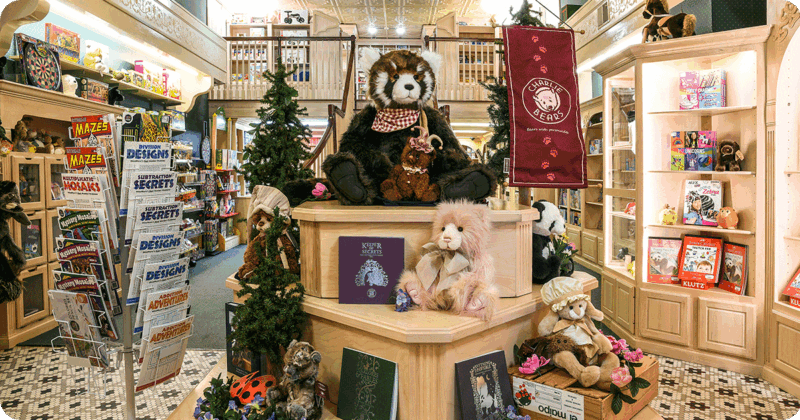
Gepetto’s Workshop in downtown Stevens Point presents an inviting atmosphere for customers.
Each year, Wisconsin Main Street partners with Milwaukee-based design firm Retailworks Inc . to provide merchandising training and assistance to businesses in multiple Main Street communities. Just as the outward appearance of a business shapes the first impression of potential customers, the interior design and layout can encourage customers to linger longer or spend more. Understanding customer psychology and designing for the customer experience is one of the most effective investments a business can make. Over the years, many businesses have received advice on ways to enhance their shops. The most common recommendations for improvements, designed to capture attention and drive sales, are highlighted in this article.
Invest in lighting
Almost all business assessments include a recommendation for more or improved lighting, whether on the establishment’s sign, in the storefront, or within the shop.
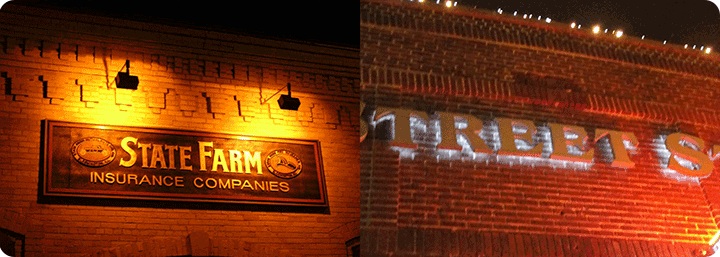
Two effective signage lighting options.
Signage should always be lit, typically with gooseneck lights, individual channel lit letters, or cutout letters that are backlit. Lighting color matters, too – look for lights that have low to mid-range Kelvin values (under 4500), which emit warm and welcoming tones, rather than cold and sterile light.
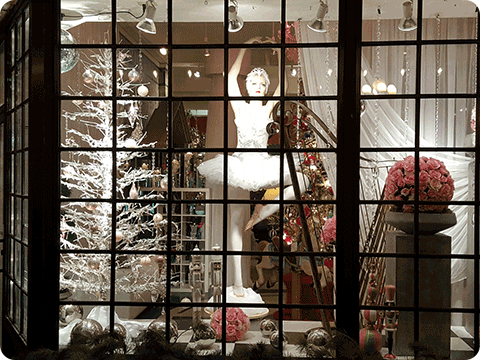
This effective display spotlights individual elements, creating visual interest.
Storefront lighting should be located close to the glass windows and spaced 18-24 inches apart for flexibility. Lights should shine back into the window display area (rather than into the eyes of pedestrians) and spotlight individual items of merchandise being displayed, creating contrast and visual interest. For service firms, having interior lights highlighting an accent wall or reception desk with the firm’s logo can create a welcoming environment (and free advertising) even when the business is not open. Window lights are often on timers, turning off after restaurant or theater traffic has ceased for the night.
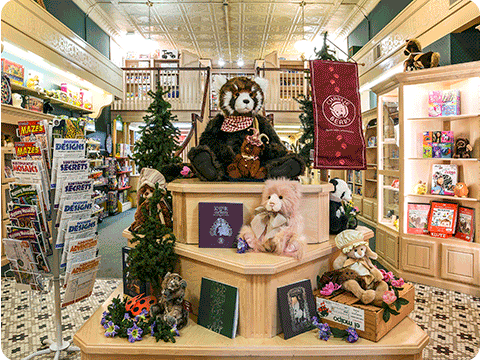
Multiple types of lighting create overall ambiance and highlight key display areas.
Store interiors require multiple layers of lighting. The store’s general overhead lighting sets the overall mood of the space. Is it dark and chill, or sunny and vibrant? Cold fluorescent lights can give off clinical vibes, while incandescent bulbs can create a homey environment. In contrast to overhead lighting, which should be consistent throughout the store, accent lighting draws customer attention to featured items or key displays. This is typically accomplished through spotlights or display lights, with focal points scattered throughout the store. Also, keep in mind that clothing, fabrics, and colors look best in warm lights, while grocery items and plants look best in brighter full-spectrum light.
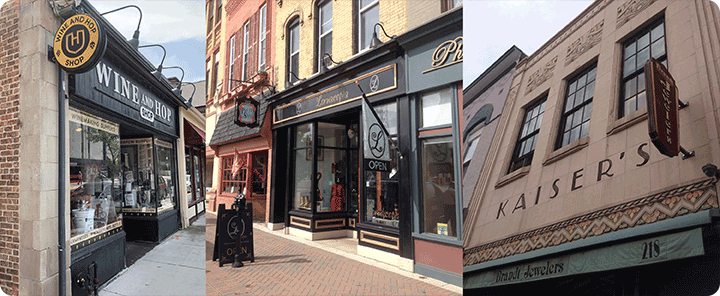
Each sign on these buildings serves a specific purpose, working together to maximize visibility.
Install more signage
Not only is signage important from the purely practical sense of helping potential customers to find you, but your sign and its quality are the primary symbol of your brand to the outside world. A critical aspect of sign design often overlooked by businesses is the need to develop a signage plan for each type of customer likely to approach the business. For instance, a horizontal sign band above the transom featuring large lettering is important for capturing automobile traffic, while projecting blade signs and window lettering are critical for helping pedestrians navigate to and understand your business. While some communities limit the number of signs that a business can install, and projecting signs often are not allowed on state roads, businesses should balance their signage allowance to incorporate all three types of signage where possible. Don’t forget that inside the store, signage is also important. In larger spaces, clearly distinguishing departments and fitting rooms is important, while smaller shops should focus on consistent and branded merchandise labels and informational signage to help the customer understand products and pricing.
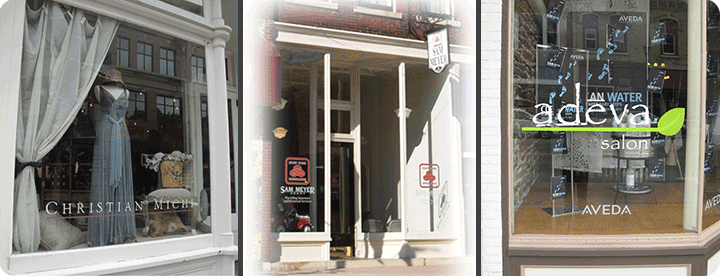
Window displays should be simple and attention-getting, whether for retail or service businesses. Light-colored vinyl signage is the most legible way to communicate business offerings.
Update your window displays
A well-merchandised window that changes with the seasons serves to catch the interest of individuals and create a reason to visit for both new and returning customers. Think of a storefront window display as a prepaid billboard for your business and treat its content the same way you would if you were paying a monthly rate for the advertising space. The merchandise doesn’t have to be expensive or elaborate, but should be colorful and eye-catching, and should convey a message to the outside world. Keep in mind that simple is best, and feature new products, top sellers, or just interesting pieces that can catch the attention of pedestrians. Not into design? The internet is a great source of inspiration for replicable displays, or consider hiring a local artist to design quarterly displays featuring products sold in the store.
Simplify your merchandising
Unless the business is an antique store or thrift market where the hunt is part of the thrill, less is always more. Get merchandise off the floor, create focused displays featuring similar items (such as those used together, Father’s Day specials, shades of green, etc.). Make sure to allow sufficient space between displays for wheelchairs or strollers to pass easily. Try to avoid having all your merchandise at the same level, or using the same display fixtures throughout the store. A mix of tall focal displays and lower shelving helps draw the eye to new items, encouraging customers to explore more of the shop.
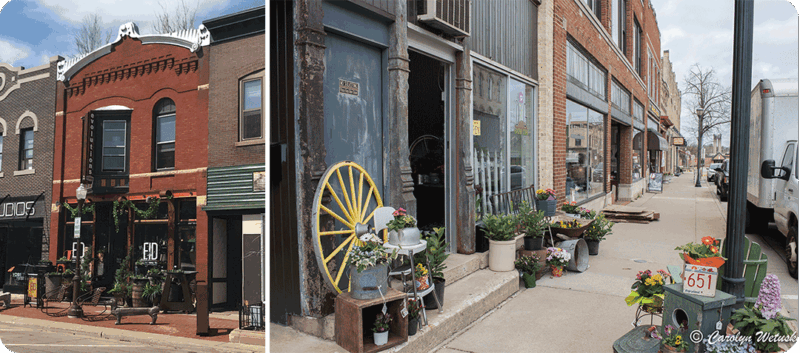
Bringing merchandise or branding elements outside reinforces the business brand and draws customers toward and into the business.
Use your outdoor space
Use your outdoor space to entice guests in the door. Regardless of the type of business, outdoor displays and signage create a sense of vibrancy and make it clear to customers that the store is open. Any combination of outdoor displays, sandwich board signs, or outdoor seating can be effective, depending on the size of your sidewalk and local regulations. While it may be obvious that outdoor seating increases restaurant sales by adding tables, adding outdoor seating to any type of business can boost traffic by making the business more inviting. Additionally, encouraging people to sit outside your business will help it look like a popular destination, enticing more potential customers to visit. Examples of effective non-restaurant seating might include a salon that adds an outdoor waiting area, a bookstore with a reading space and Little Free Library, or a running shop with a stretching station or post-run seating with shade.
While any of these improvements come with a price tag, when done correctly, the investment should pay off in increased foot traffic and sales. For more information on future merchandising training opportunities, contact your local downtown organization or follow Wisconsin Main Street on social media.
